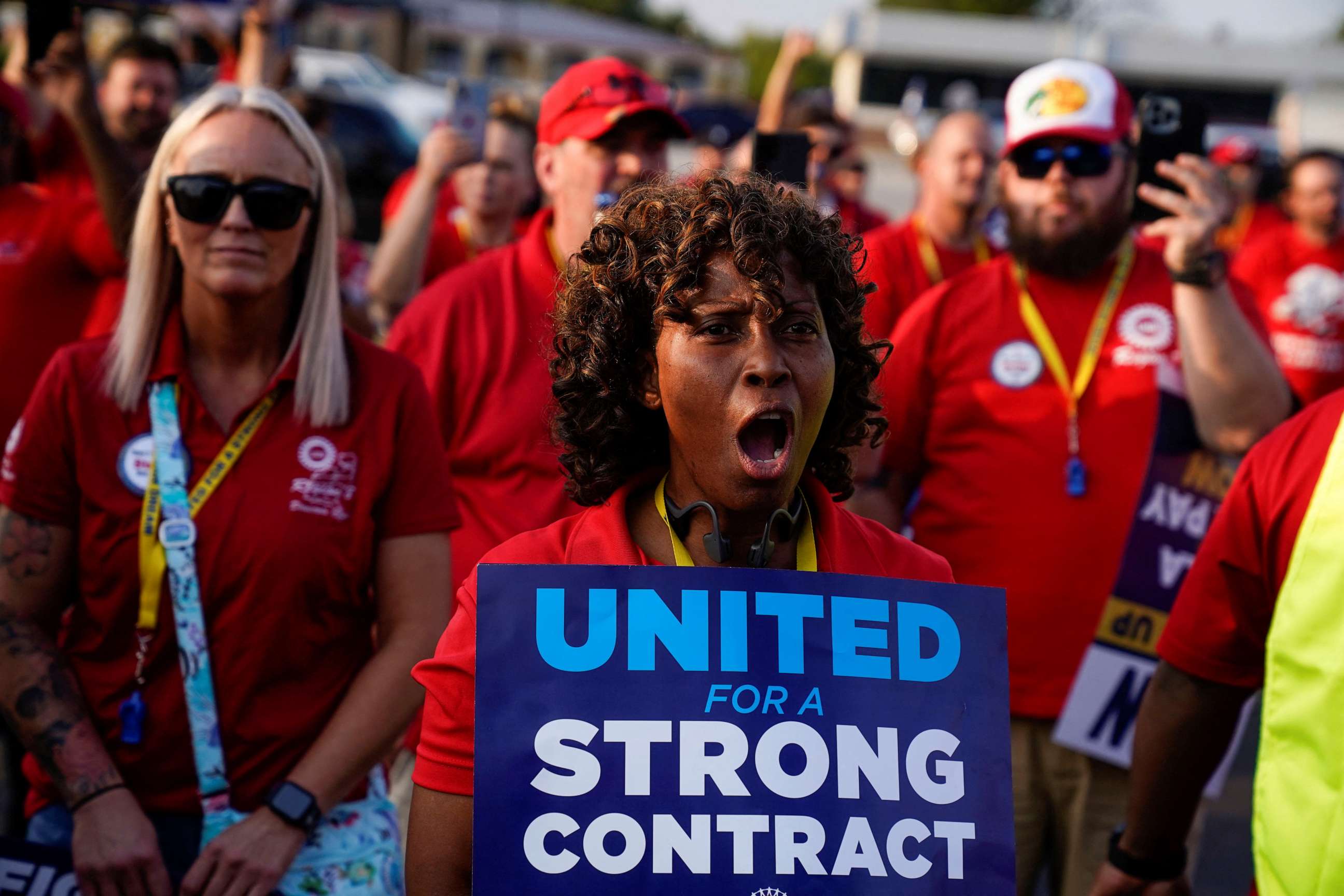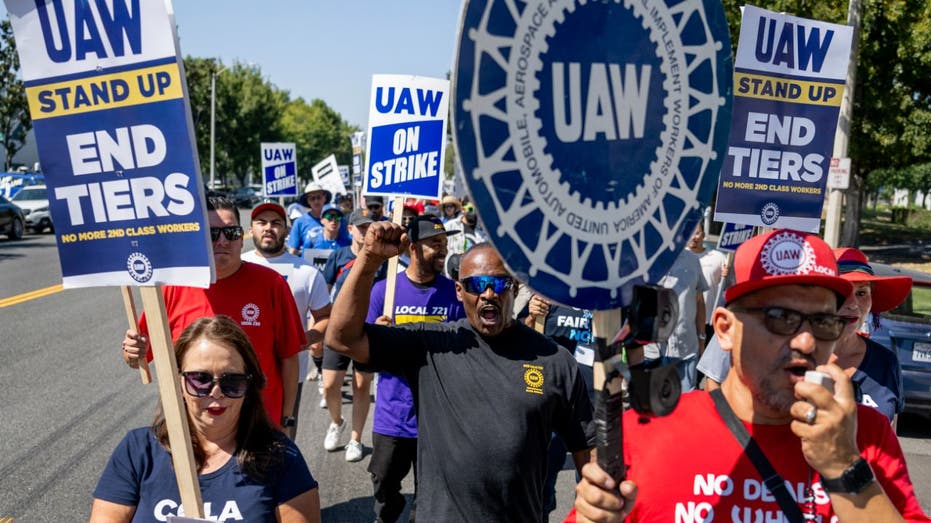UAW Ramps Up Strike at Ford and GM, but Sees Encouraging Progress at Stellantis

UAW Ramps Up Strike at Ford and GM, but Sees Encouraging Progress at Stellantis
In a dramatic escalation of the ongoing labor dispute, the United Auto Workers (UAW) union has announced its decision to expand the strike to encompass one additional assembly plant each at Ford and General Motors (GM). However, amidst this mounting tension, there appears to be a glimmer of hope in the form of progress at Stellantis, a leading automotive manufacturer. With picket lines growing and negotiations continuing, the future of labor relations in the automotive industry hangs in the balance.
UAW President Shawn Fain delivered this latest development during a live-streamed update on Friday, shedding light on the union’s strategy and the factors driving these decisions. The new facilities scheduled to go on strike at noon on Friday include Ford’s Chicago Assembly plant, responsible for manufacturing the popular Ford Explorer and Lincoln Aviator SUVs, and GM’s Lansing Delta Township assembly plant in Michigan, which produces the Chevrolet Traverse and Buick Enclave SUVs. This move will see an additional 7,000 UAW members joining the picket lines, bringing the total number of striking union members across all three major automakers to an impressive 25,000.
However, the situation at Stellantis, known for its Jeep, Ram, Dodge, and Chrysler brands, offers a departure from this intensifying conflict. According to President Fain, last-minute negotiations at Stellantis are keeping the union from expanding its picket lines there. This unexpected development seems to indicate a divergence in the union’s approach, with Fain expressing optimism about the ongoing talks at Stellantis, saying, “We’re excited about this momentum at Stellantis and hope it continues.”
From the outset, the UAW had signaled its intention to widen the scope of the strike if negotiations failed to meet their expectations. Despite this growing discord, President Fain was keen to clarify that negotiations have not broken down entirely. He stated, “We’re still talking with all three companies, and I’m still very hopeful we can reach a deal that reflects the incredible sacrifices and contributions that our members have made over the last decade.”

While the UAW’s decision to expand the strike may not come as a complete surprise, it has not been without its critics. In response to the union’s move, GM expressed its dissatisfaction with the situation, fueling the already heated debate surrounding labor negotiations.
Growing Picket Lines
The decision to expand the strike at Ford and GM marks a significant escalation in the ongoing labor dispute between the UAW and the major automakers. Thousands of additional workers are now standing in solidarity on the picket lines, seeking to leverage their collective bargaining power to secure better wages, benefits, and working conditions.
At Ford’s Chicago Assembly plant, the production of Ford Explorer and Lincoln Aviator SUVs has come to a standstill. These popular vehicles have been essential to Ford’s product lineup, and their absence from the market could potentially impact the company’s bottom line. Similarly, the strike at GM’s Lansing Delta Township assembly plant, responsible for manufacturing the Chevrolet Traverse and Buick Enclave SUVs, has disrupted the production of these vehicles, further compounding the impact on the automotive industry.

An Industry in Turmoil
The UAW’s decision to expand the strike comes at a time when the automotive industry is already grappling with numerous challenges. Supply chain disruptions, semiconductor shortages, and the transition to electric vehicles have put immense pressure on automakers. The labor dispute exacerbates these difficulties, potentially leading to a more profound impact on the industry as a whole.
With the strike now affecting two additional facilities, Ford and GM are facing increased production disruptions, which could, in turn, affect their supply chains and dealership networks. Consumers may experience delays in receiving vehicles, and dealerships may see a reduction in available inventory. These ripple effects have the potential to dent the already strained global automotive market.
Hope on the Horizon
Amidst the growing tension, there is a ray of hope in the form of ongoing negotiations at Stellantis, which appear to be progressing positively. Stellantis is known for its iconic brands such as Jeep, Ram, Dodge, and Chrysler, and a resolution to the labor dispute at their facilities could serve as a template for resolving the conflicts at Ford and GM.
The UAW’s decision not to expand picket lines at Stellantis suggests that both parties are committed to finding common ground through dialogue and negotiation. This contrasts with the more confrontational approach taken at Ford and GM.

A Divided Response
General Motors, in particular, has expressed its dissatisfaction with the UAW’s decision to expand the strike. The company criticized the move, highlighting the potential negative consequences it could have for GM and its employees. This dissent underscores the deep divide between labor and management in the automotive industry.
GM’s response reflects the significant stakes involved in this labor dispute. The company, like its competitors, is facing an array of challenges that could be exacerbated by a protracted strike. Balancing the demands of unionized labor with the economic realities of the automotive market is a delicate and complex task for management.
The Road Ahead
As the strike expands at Ford and GM, and negotiations continue at Stellantis, the future of labor relations in the automotive industry remains uncertain. The decisions made in the coming days and weeks will have far-reaching consequences, not only for the companies and their employees but also for the broader economy.
The UAW’s expansion of the strike is a clear signal of the union’s determination to secure better terms for its members. However, it also raises questions about the long-term viability of such confrontational tactics in an industry facing unprecedented challenges.
The hope lies in the ongoing talks at Stellantis, where both labor and management seem willing to engage in meaningful dialogue. If a resolution can be reached there, it may serve as a blueprint for resolving the disputes at Ford and GM, offering a path forward for all parties involved.
In the meantime, the automotive industry and its stakeholders must brace themselves for continued uncertainty, as the battle between labor and management plays out on picket lines and negotiation tables across the country. The road ahead remains uncertain, but the outcome will undoubtedly shape the future of the American auto industry.




